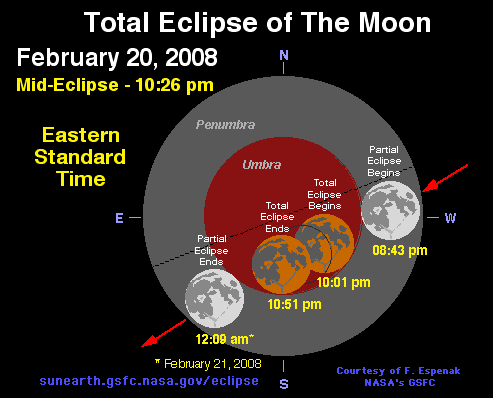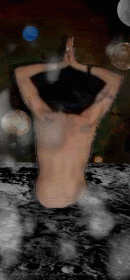From: jerm: rant in j-minor
Date: Feb 19, 2008 7:31 PM
Lunar Eclipse Info----------------- Bulletin Message -----------------
THANX: The Ghost of Jake
Date: Feb 19, 2008 3:22 PM
Ideas Are Bulletproof
UFOtv ♥♥♥ Living in the Now ♥ Trusting ♥♥♥
seva ♥♥♥ Living in the Now ♥ I found the 1
Freespirit
12:12
EarthBorneRising.com
Rogue
Bobby
∴Trinity∴
..
Lunar Eclipse on February 20 2008
A Total Eclipse of the Moon
..
The moon dips into Earth's shadow for a total lunar eclipse on the night of
Wednesday, February 20, 2008.
On February 20, 2008, the moon, Earth, and sun line up causing a total lunar eclispe.
The next total lunar eclipse does not occur until December 21, 2010,
although a couple partial and penumbral lunar eclipses will occur between
now and then.
Is the Eclipse on February 20 or 21?
What day the eclipse occurs on depends on your location.
Europeans will see the eclipse on the 21st, while most residents of North America will view it on the
evening of the 20th.
For those on the East Coast, the eclipse starts on the evening of Wednesday, February 20,
and ends just after midnight in the early hours of Thursday, February 21.
Locations and Times for Eclipse Viewing
The lunar eclipse will be visible in its entirety from western Europe and Africa,
all of South America, and central and eastern North America.
The moon will already be in eclipse phase during moonrise for the western US,
including Alaska.
The shadow of Earth will creep across the face of the brightly lit full moon for more than an hour
before totality occurs.
The total phase will last approximately 50 minutes.
Here are some of the moments of contact for different time zones:
Eastern Time:
Partial Phase Begins at 8:43 pm, Total Phase Begins at 10:01 pm, Total Phase Ends at 10:51 pm, Partial Phase Ends at 12:09 am (February 21)
Central Time:
Partial Phase Begins at 7:43 pm, Total Phase Begins at 9:01 pm, Total Phase Ends at 9:51 pm, Partial Phase Ends at 11:09 pm
Mountain Time:
Partial Phase Begins at 6:43 pm, Total Phase Begins at 8:01 pm, Total Phase Ends at 8:51 pm, Partial Phase Ends at 10:09 pm
Pacific Time:
Partial Phase Begins at 5:43 pm, Total Phase Begins at 7:01 pm, Total Phase Ends at 7:51 pm, Partial Phase Ends at 9:09 pm
Why Lunar Eclipses Occur
Lunar eclipses must occur during a full moon.
For the moon to be full, it has to lie on the opposite side of Earth from the sun.
Most months when the moon is full, the line made by the Earth, sun, and moon does not line up
perfectly for the moon to enter Earth's shadow.
Lunar eclipses only occur about twice a year, and even then, not all lunar eclipses are total eclipses.
Recent volcanic eruptions in South and Central America may cause the eclipsed moon there to take on
a blue, black, or violet hue. The particles in the atmosphere are what give the eclipsed moon its colors.
Normally the hue is orangish or reddish, due to the colors of sunrise and sunset on the limbs of the
Earth where the sun passes through and the color is projected onto the moon.
Lunar eclipses, unlike solar eclipses, do not require any special precautions or viewing equipment.
A lunar eclipse can be viewed without binoculars or a telescope.
Try taking a photograph of the eclipsed moon; a large zoom lens will come in handy.
Other Lunar Observing Highlights
On February 20, the same night as the lunar eclipse, the moon will lie in the constellation Leo very near Saturn and Regulus.
The backward question-mark shape that marks Leo the Lion's head lie to the north. The period in the question mark is Regulus, shining at magnitude 1.4. During the eclipse it lies about two degrees from the moon.
Saturn, the brighter point of light near the moon, shines at magnitude 0.2, a little less than four degrees from the moon. Use a telescope to spot Titan, Saturn's largest moon. Scientists believe an ocean lies under Titan's icy surface, making Titan one of the most likely places in the solar system outside of Earth to harbor life.
Close Encounters with Venus
Venus's first conjunction of the month occurs on the first day of the month in the early hours before sunrise. On February 1, Jupiter and Venus lie just a half degree apart, or about half the amount of sky covered by your pinky when held at arm's length.
Look east-southeast about two hours before sunrise as the duo rises above the horizon. Venus will be a stunning bright light at magnitude -3.9. Jupiter will hold its own at magnitude -1.8. The two planets will be above the teapot asterism in the constellation Sagittarius.
As a bonus for getting up early to see the conjunction, look just two degrees to the right of the planets to find globular cluster M22. Under dark enough skies it can be seen without binoculars or a telescope.
If you do have binoculars or a telescope, use them to take a better look at the conjunction and globular cluster. Even better, take a photo if you are so inclined. A telescope will show Jupiter’s four largest moons. These moons, called the Galilean moons, are the four satellites orbiting Jupiter. Jupiter and its moons will be lined up, from lower left to upper right, in this order: Callisto, Europa, Io, Jupiter, and Ganymede. Remember that if you are looking through a telescope the image will be inverted.
February's second great conjunction occurs on the morning of February 27. Venus has moved away from Jupiter and is now by Mercury in the constellation Capricornus. Venus will still be at magnitude -3.9 and Mercury will be shining at magnitude 0.2. Venus will be closer to the horizon with Mercury about one degree above. The two planets will rise only about one hour before the sun and therefore be harder to catch than the conjunction at the beginning of the month.
Eclipse of the Moon Among the Constellations
Wednesday evening February 20, 2008
..
In the constellation of Leo the Lion, the eclipse of the Moon will occur towards the southeast portion of the sky.
Off to the left of the Moon, you can see the planet Saturn.
Of course the sky would appear to be moving over the course of time during the eclipse.
The size of the Moon is exaggerated for this graphic.
Our Moon thirty minutes after sunset for February 17.
..
Enjoy Eclipse Chasing???
Join My Group!!!
Eclipse Chasers
See You On the DARK Side of the MOON,
 ∴Trinity∴
∴Trinity∴

No comments:
Post a Comment